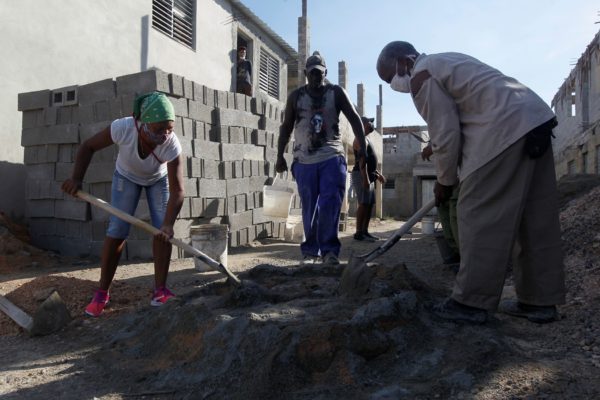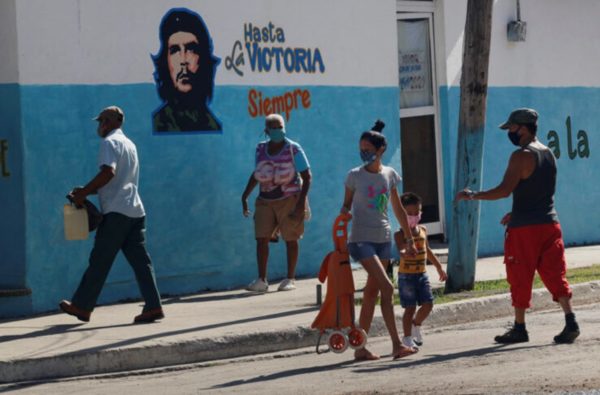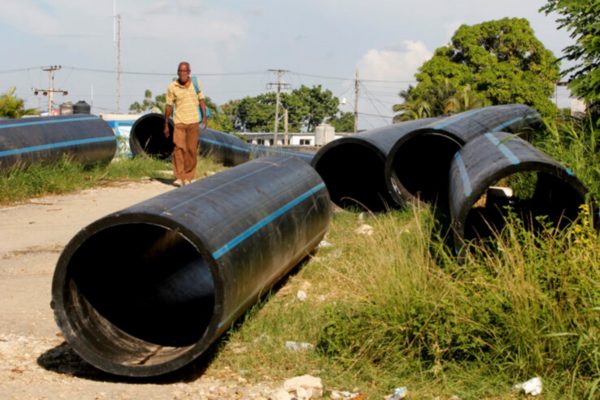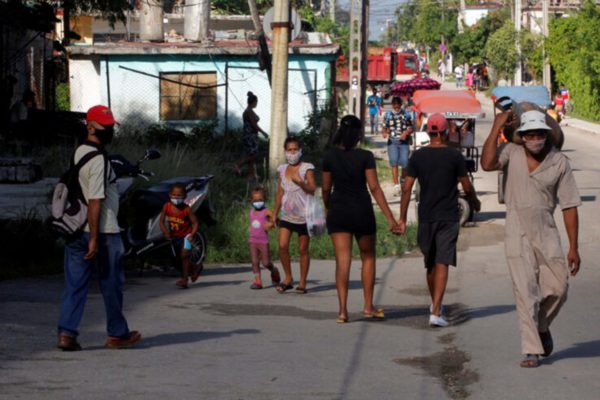The Cuban Government Tries to Address Social Gaps

HAVANA TIMES – Julia Fis longs for the moment when she’ll receive the keys to a comfy home, similiar to the 18 houses she’s helping to build in the El Comodoro community in the marginal neighborhood La Guinera, in the Cuban capital.
Now living with one of her two sons in a makeshift house in Managua, on Havana’s southern border, Fis is a member of the construction brigade that received an injection of materials, a few weeks ago, to finish the block of duplex apartments, that had started to be built two years ago, in one of the areas classified as “underprivileged” in the city, where 2.2 million people live.
“I’ve been waiting for a decent home for 23 years. I’m on the list to get a house, but my case has been delayed for one reason or another, which I have reported in letters addressed to superior bodies (the central government),” Fis told IPS during a tour of the place.
Over the past few weeks, 62 neighborhoods in the capital, identified as having more complex social problems, began to receive support from government ministries and institutions to try and resolve some basic needs.
Such actions aren’t new in a country with a political system that declares itself to be socialist, with programs to provide shelter for people and groups in a vulnerable situation, and with social protections linked to universal and free access to services such as education and public health.
“And why are we doing this now and not years ago? Because we were in lethargy… in paralysis and we have to recognize this,” -Miguel Diaz-Canel.
However, protests on July 11th in some 40 cities and towns on this Caribbean island of 11.2 million inhabitants, exposed some of the effects that result from increasing social inequality, analysts point out.
The government has attributed the protests to an “intense political/media operation funded by the US government”, which had the mission of “spurring on riots and instability in the country”, within a framework of unconventional war.
Political experts consulted by IPS argue that the unhappiness displayed by a group of citizens revealed their stress as a result of shortages of food, medicines and basic essentials, and the existence of stores that sell some of these products but in foreign currency, which a significant part of society don’t have access to.
While the economic reforms strategy that was launched on January 1st did include a raise in wages, pensions and state subsidies for vulnerable people, it also triggered an increase in prices and high inflation that has reduced the purchasing power of many families.
This landscape is made bleaker by the US embargo, which has been in force since 1961, and was reinforced with over 200 measures during former president Donald Trump’s administration (2017- Jan 2021), and whose extraterriorial impact has made it hard for Cuba to access credits, direct foreign investment and loans from leading international financial organizations.

Rifts
The island has been suffering a structural crisis with its centralized economy for three decades, with low growth rates that have negatively affected its development plans.
Cuba lacks updated statistics to express how these factors have influenced the Poverty Threshold, which makes it difficult to measure vulnerability and marginalization, social scientists have pointed out.
Nevertheless, the Multidimensional Poverty Index (MPI), a tool developed by the Oxford Poverty & Human Development Initiative and the UN Development Program (UNDP), stood at 0.15% of the Cuban population in 2017.
MPI takes into account three dimensions of wellbeing – health, education and quality of life – each of these with indexes about tangible assets and sevices, going beyond the financial dimension of poverty.
Studies systematized by Cuban researcher Maria del Carmen Zabala during 2008-2018 highlight the disadvantages in some areas, such as those located in the eastern region, in rural areas and Havana neighborhoods without basic services.
According to Zabala, the key elements that constitute poverty and vulnerability in the Cuban context are insufficient wages and other assets, mainly homes, both because of the housing deficit as well as their gradual decline.
By the end of 2020, Cuba had 3,946,747 homes out of which 37% were reported to be in a regular or poor technical state, along with a housing deficit of almost 863,000 residences, official figures state.

Living in Diez de Octubre, the most densely-populated out of Havana’s 15 municipalities, Denisse Hernandez talked to IPS about the renovation of public bodies in her environmnet, such as a business and a fruit and vegetable market.
However, she believes that “these actions don’t hold a lot of weight against the profound and extensive rebuilding work that, for example, Calzada de Diez de Octubre needs, which has hundred-year-old homes in a very deteriorated state. Yet these might not be the places that are in desperate need of repairs, like the old La Vibora ice cream parlor or the streets themselves.”
In any case, Hernandez said that “something being renovated is always positive for the community, even when there’s so much left to do still.”
Counting on the community
In addition to housing, the Cuban government’s new plan focusses on finding a solution to other problems such as drinking water supplies, garbage collection, paving roads and repairing health networks, as well as creating spaces to bring services to the areas farthest away from Havana’s city center.
It is also suggesting that young people who left their studies go back to school or get a job.
One of the plan’s missions is to identify the most pressing needs in each place, get people involved with the transformation work, and support community projects, some with vast experiencing working in neighborhoods without institutional support.

“And why are we doing this now and not years ago? Because we were in lethargy… in paralysis and we have to recognize this,” president Miguel Diaz-Canel said on October 1st, during a meeting with presidents of the 168 local governments in the country, as well as governors and secretaries of the Communist Party (the only legal party in the country) from the 15 provinces.
The leader, who recently visited Havana’s neighborhoods, has urged for social science centers to accompany them in this process.
Multidisciplinary teams from th Psychological and Sociological Research Center (CIPS) and the National Institute of Economic Investigation (INIE), based in Havana, have spoken to citizens, community leaders, social organizations and officials in the La Timba neighborhood, in the Plaza de la Revolucion municipality.
“We have found pressing needs linked to improving living conditions, quality of life and public services,” social researcher Ovidio D’Angelo, a member of CIPS work team, told IPS.
In his opinion, key public policies need to focus on “prioritized attention to the material and spiritual conditions in these areas of social vulnerability; training neighborhood leaders and community groups to push forward programs and projects, getting young people involved, with a focus on gender and social status.”
Meanwhile, D’Angelo added that “profound changes [are needed] in the style of social communication and systematic multi-stakeholder dialogue when decisions are being made at every level of government; in addition to developing civic engagement mechanisms and popular control, amongst others.”
City councillors, elected every five years by their communities, are a key figure in communication between neighborhoods and government structures, but their work has been affected by a lack of resources and real power to effectively find a solution, citizens and experts say.
Since 2019, the government has been pushing a policy to deliver homes or subsidies for renovations, to over 28,600 mothers with three or more children aged 17 and under.
Up until now, 5700 of the over 28,500 mothers identified across the country have had their cases resolved, according to official information.





Hope is all that is left after sixty two years of communism. One of Fidel Castro’s last public statements, made on February 24th, 2013 at the Communist Party of Cuba Congress, was:
“The great battle to be imposed is the need for an energetic struggle without respite against the bad habits and errors being committed daily by many citizens including Party members in the most diverse spheres.”
This was followed on July 7, 2013, by Raul Castro’s summation:
“Thus part of society has come to see theft from the state as normal. There has been propagation of illegal constructions with relative impunity moreover in inappropriate sites, non-authorizedoccupation of housing, illicit marketing of goods and services, non-fulfillment of working hours, illegal cattle rustling and slaughter, capture of marine species in danger of extinction and utilization of the art of fishing, felling of forestry resources including in Havana’s magnificent Botanical Gardens, the hoarding of products in short supply and of bribes and their resale at higher prices, participation in games outside the law, price violations, the acceptance of bribes and privileges, preying on tourism and infraction of established regulations related to informatics security.”
Clearly, the Castro brothers recognized the reality of the consequences of their prolonged dictatorship. Although Fidel sequestered in his compound at Siboney said little further, Raul reflected further:
“I have the bitter feeling that we are a society constantly more instructed but not necessarily more educated.”
Now, Diaz-Canel suggests on October 1st, 2021, that during the Castros direct reign of over fifty seven years little was achieved:
“Because we were in lethargy…in paralysis and we have to recognize this.”
There lies the proof! In Cuba, nothing has changed!
”
‘